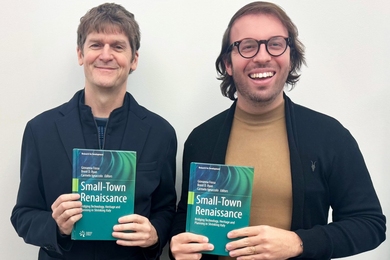Controversy over the benefits of using corn-based ethanol in vehicles has been fueled by studies showing that converting corn into ethanol may use more fossil energy than the energy contained in the ethanol produced. Now a new MIT analysis shows that the energy balance is actually so close that several factors can easily change whether ethanol ends up a net energy winner or loser.
Regardless of the energy balance, replacing gasoline with corn-based ethanol does significantly reduce oil consumption because the biomass production and conversion process requires little petroleum. And further MIT analyses show that making ethanol from cellulosic sources such as switchgrass has far greater potential to reduce fossil energy use and greenhouse gas emissions.
The Bush administration is pushing the use of ethanol as a domestically available, non-petroleum alternative to gasoline. But most U.S. ethanol is now made from corn, and growing corn and converting the kernels into ethanol consume a lot of energy--comparable to what is contained in the ethanol produced. Making ethanol from corn stalks, other agricultural wastes and wild grasses would consume less energy, but the technology for converting them to ethanol may not be economically viable for another five or so years.
Does using corn-based ethanol in place of gasoline actually make energy consumption and emissions go up, as some researchers claim? Why do others reach the opposite conclusion? And how much better would ethanol from "cellulosic" feedstocks such as switchgrass be?
To answer those questions, Tiffany A. Groode, a graduate student in MIT's Department of Mechanical Engineering, performed her own study, supervised by John B. Heywood, Sun Jae Professor of Mechanical Engineering.
Using a technique called life cycle analysis, she looked at energy consumption and greenhouse gas emissions associated with all the steps in making and using ethanol, from growing the crop to converting it into ethanol. She limited energy sources to fossil fuels. Finally, she accounted for the different energy contents of gasoline and ethanol. Pure ethanol carries 30 percent less energy per gallon, so more is needed to travel a given distance.
While most studies follow those guidelines, Groode added one more feature: She incorporated the uncertainty associated with the values of many of the inputs. Following a methodology developed by recent MIT graduate Jeremy Johnson (Ph.D. 2006), she used not just one value for each key variable (such as the amount of fertilizer required), but rather a range of values along with the probability that each of those values would occur. In a single analysis, her model runs thousands of times with varying input values, generating a range of results, some more probable than others.
Based on her "most likely" outcomes, she concluded that traveling a kilometer using ethanol does indeed consume more energy than traveling the same distance using gasoline. However, further analyses showed that several factors can easily change the outcome, rendering corn-based ethanol a "greener" fuel.
One such factor is the much-debated co-product credit. When corn is converted into ethanol, the material that remains is a high-protein animal feed. One assumption is that the availability of that feed will enable traditional feed manufacturers to produce less, saving energy; ethanol producers should therefore get to subtract those energy savings from their energy consumption. When Groode put co-product credits into her calculations, ethanol's life-cycle energy use became lower than gasoline's.
Another factor that influences the outcome is which energy-using factors of production are included and excluded--the so-called system boundary. A study performed by Professor David Pimentel of Cornell University in 2003 includes energy-consuming inputs that other studies do not, one example being the manufacture of farm machinery. His analysis concludes that using corn-based ethanol yields a significant net energy loss. Other studies conclude the opposite.
To determine the importance of the system boundary, Groode compared her own analysis, the study by Pimentel and three other reputable studies, considering the same energy-consuming inputs and no co-product credits in each case.
"The results show that everybody is basically correct," she said. "The energy balance is so close that the outcome depends on exactly how you define the problem." The results also serve to validate her methodology: Results from the other studies fall within the range of her more probable results.
Growing more corn may not be the best route to expanding ethanol production. Other options include using corn stover (the plants and husks that are left on the field), or growing an "energy crop" such as switchgrass. While corn kernels are mostly starch, corn stover and switchgrass are primarily cellulose. Commercial technologies to make ethanol from cellulose are not yet available, but laboratory and pilot-scale tests are generating useful data on processing techniques. So how do cellulosic sources measure up in terms of saving energy and reducing greenhouse gas emissions?
Using her methodology, Groode performed an initial analysis of switchgrass and, drawing again on Johnson's work, corn stover. She found that fossil energy consumption is far lower with these two cellulosic sources than for the corn kernels.
Farming corn stover requires energy only for harvesting and transporting the material. (Fertilizer and other inputs are assumed to be associated with growing the kernels.) Growing switchgrass is even less energy intensive. It requires minimal fertilizer, its life cycle is about 10 years, so it need not be replanted each year, and it can be grown almost anywhere, so transport costs can be minimized.
Groode and Heywood now view the three ethanol sources as a continuum. In the future, cellulosic sources such as corn stover and ultimately switchgrass can provide large quantities of ethanol for widespread use as a transportation fuel. In the meantime, ethanol made from corn can provide some immediate benefits.
"I view corn-based ethanol as a stepping-stone," said Groode. "People can buy flexible-fuel vehicles right now and get used to the idea that ethanol or E85 works in their car. If ethanol is produced from a more environmentally friendly source in the future, we'll be ready for it."
This research was supported by BP America.
A report on Groode's work, titled "Review of Corn Based Ethanol Energy Use and Greenhouse Gas Emissions," can be downloaded at lfee.mit.edu/metadot/index.pl?id=2234.
A version of this article appeared in MIT Tech Talk on January 24, 2007 (download PDF).






